
Chemical Signature of Household Cleaning Products to Unveil Crime – Forensic Evaluation of Case Study
*Corresponding Author(s):
Sweta SinhaJunior Forensic Assistant Chemical Examiner, Chemistry Division, Forensic Science Laboratory, Delhi, India
Tel:+917838664526,
Email:sweta.fsl@gmail.com
Abstract
Crime related to household cleaning products is highly prevalent in India owing to its easy availability in residential and commercial spaces. National Crime Records Bureau of India also marks escalating crime related to household cleaning products. With the advent of large variety of commercial household cleaners, their constant changing ingredients and due to high volatility of their chemical constituents; its detection in biological fluids becomes complex and challenging task for any forensic analyst. This study pertaining to household cleaning product poisoning is presented after descriptive toxicological screening to elucidate volatile chemical compounds present in biological samples and household cleaning products as well as highlight significant reasons for successful detection. Previously, domestic cleaners contained primarily phenol or cresols along with other additives, but in the present cases, these compounds could not be detected, rather a very broad spectrum of organic volatile compounds were detected. Consequently, few available commercial household cleaners were randomly selected and subjected to analysis on Head Space – Gas Chromatography – Mass Spectrometer (HS-GC-MS) to understand their volatile chemical composition. HS-GC-MS is versatile and sensitive instrument for identification of volatile substances providing quick, accurate and reproducible result. The clear range and distinctive pattern of chemicals identified in both commercial products and case exhibits enabled forensic analyst to deduce results efficaciously and diminish potential setbacks obstructing the road to justice. A systemic evaluation in this study not only emphasize on constituents of cleaning products but can also pinpoint the exact reason in unknown poisoning cases containing similar chemical constituents, finally, to assist rapid forensic reporting.
Keywords
Forensic; Household cleaners; Head Space – Gas Chromatography – Mass Spectrometer; Poisoning; Volatile
Introduction
Household cleaners are extensively used in day-today cleaning process. But, sometimes, they are exploited for malafide intentions as encountered in numerous cases of Suicidal, Homicidal and Accidental poisoning mainly due to their easy accessibility and lack of legal control [1]. Accidental ingestion is the most frequent route of exposure although cases of suicidal and homicidal poisoning have also been reported [2, 3]. Death has been reported from acute poisoning due to of high toxic potential of these cleaning products [4, 5]. National Crime Records Bureau (NCRBI) report marks household product poisoning under most common poisoning cases in India [6].
As these products are easily accessible at residences and workplaces without any legal restrictions, their use in crime must draw distinct attention of enforcement agencies, medical officers, judiciary and forensic analyst. With the arrival of sophisticated techniques in the sphere of medical and forensic examination, the outcome of such cases can prove more significance for judiciary however essential documentation during initial medico legal findings and relevant evidence collection in time are some of the major challenges faced by forensic experts. Due to large variety of these cleaning products, their frequently changing constituents, highly volatile nature of constituents and their possible metabolism in body, their detection in body fluids pose much tougher challenge to forensic analyst [7]. Also, sample collection and preservation play a substantial role in chemical analysis of crime exhibits. Previously, phenol or locally made dilute acids were used as cleaning products and could be easily identified in forensic samples [8, 9]. Currently, lack of consolidated data in biological fluids specifying these volatile organic chemicals to establish cleaning products poisoning stand tall in front of forensic analyst while examination of poisoning cases [5, 10].
The major symptoms in cleaning products poisoning are nausea, vomiting or abdominal pain which can mimic common stomach upset. Sometimes, severe physiological effects like corrosions, haematemesis with perforation acidosis, central nervous system depression, aspiration pneumonia, and hepatic/renal damage may also be observed, depending on the dose of ingestion. The effect of poisoning often depends on the age and health of a person, condition of stomach like empty or full, health of stomach including condition of internal mucosa and duration of first medical aid. The toxicity is mainly due to several physiological affects observed [11-13].
At present, there is large void in precise standard formulations for house hold cleaners, although chemical composition is mentioned on the label of the product which generally varies from manufacturer to manufacturer [14]. Many of these household cleaners contain a variety of potentially toxic constituents which are complex mixture of chemicals, mainly responsible for metabolic acidosis [3]. The chemical composition of common cleaning products includes, inter alia, surfactant, antimicrobials, solvents and some basic organic ingredients like dyes, fats, oils, ammonia and fragrance materials [15]. Study on effects of cleaning products on environment were undertaken by Thomas et al [16] whereas Yadav P whereas Singh R et al reported Thin Layer Chromatographic separation of Floor Cleaners [17] but shortage of substantial data related to common household cleaning products constituent with respect to biological samples was observed by the authors. This can be mainly due to large variety of products with varied chemical composition, highly competitive market, consumerization and therefore identification and detection of chemicals specially in biological samples develop countless challenges during investigation. Thus, for a registered case under IPC to reach conviction stage, stringent and accurate measures are needed from the time of incidence to initiation of investigation, medico legal examination, precise collection of evidence, chemical examination in forensic laboratories besides testimony. Further, the detection of poison becomes more challenging in forensic laboratories upon subsequent medical treatment of victims. Evidence collection by medical experts is preferred at initial stages as delay may lead to loss of evidence in biological fluids. Julie et al demonstrated drug recovery of 38% in Gastric lavage performed within 15 to 20 minutes of ingestion which reduced to 13% when performed after 60 minutes [18]. Here, it is important to mention that time elapsed between occurrence of incidence and medical assistance plays a very vital role in chemical analysis in poisoning cases. Additionally, in these poisoning cases, the evidence collected from the scene of crime and from hospital during medico legal examination, both perform equal contribution throughout investigation including verbal testimony. Other factors like packaging, storage, transportation, chain of custody and time duration between incidence and forensic analysis etc will likewise regulate whether the submitted evidences for examination fulfill minimum requirement for appropriate reporting or to reach desired results. The prime objective of this manuscript is analysis of available market household cleaners in order to mark the volatile chemicals present besides their identification in biological samples by instrumental technique HS-GC-MS for interpretation of results in forensic case samples to act as a barrier in investigation and link crime and victim. Two cases are considered here for study which were received at Forensic science laboratory for chemical examination where various associated parameters were observed to understand the results obtained and harmonized with chemical signature of randomly selected commercial cleaning products.
Case Study – I
A 26-year-old married women was admitted to hospital with an alleged history of ingestion of poison as deliberate suicidal attempt. Doctor preserved gastric lavage for forensic chemical analysis. The victim was admitted within few hours (8 hours) of incidence with symptoms of abdominal pain and vomiting along with anxiety and nausea. As per medico-legal certificate (MLC) she was conscious, oriented and fit for statement. Further investigation revealed disturbed family relationship.
Case Study – II
A 48-year-old male was brought to hospital by his wife suspected to consume of some unknown substance as suicidal attempt. As per case history, he was habitual alcoholic and had consumed some household cleaning product for which was subsequently hospitalized after 12 hours of occurrence of incidence. The MLC report stated victim to be conscious and confused but unable to speak clearly with history of vomiting and respiratory distress. Later, victim became unconscious and expired during treatment. Gastric lavage was sent for forensic chemical analysis along with some white liquid (suspected liquid to have consumed), seized by the Investigating Agency.
Materials and Methods
Chemicals and Reagents: Deionized Water from Elga Flex water purifier and all glasswares used were from Borosil. Common household cleaners were obtained from local market for analysis marked as A, B, C, D, E, F and G respectively and were used as working standard.
Chemical Analysis: Qualitative analysis of volatile organic poisons was performed using hyphenated chromatographic technique (HS-GC-MS) and routine screening for drug and pesticide poisoning of case samples were carried out as per standard protocol followed in forensic laboratories.
Sample preparation for HS-GC-MS: One ml of the case exhibits (Gastric Lavage) was taken in vial. 10 µL of suspected liquid sample (case exhibit) and purchased cleaning products (A, B, C, D, E, F & G) were transferred into separate headspace (HS) vials and 90 µL of deionized water was added to constitute 1ml solution. All the vials were immediately crimped and subjected to instrument Head Space – Gas Chromatography – Mass Spectrometer (HS-GC-MS).
Sample 1 and 2 – Gastric Lavages of case I (marked as case exhibits 8&9 in table I)
Sample 3 – Gastric Lavage of case II (marked as case exhibits 10 in table I)
Sample 4 – Suspected Liquid of case II (marked as case exhibits 11 in table I)
Instrumentation
Headspace-Gas Chromatography-Mass Spectrophotometry: HS-GC-FID/MS method:
An Agilent Gas Chromatograph (Agilent 7890B) coupled with Head Space Sampler (7697A), FID and Mass Selective Detector ((MSD 5977A)) was used for examination of samples and standards in configuration HS-GC-FID/MS. Helium was used as the carrier gas. Separation of analytes was carried out in DB-5MS capillary column (5% phenylmethylpolysiloxane) having dimensions 30m × 0.25 mm × 0.25 μm. In the Headspace parameters (HS) the oven was maintained at 70 °C with the transfer line temperature at 130 °C. The vials were incubated for 15 min at 70 °C before injection of the sample. The injection time was held constant at 1 min and instrument operated in split mode with split ratio of 30:1, pressure of 9.7 psi, septum purge flow of 5 ml/min. The GC was programmed at an initial oven temperature of 40 °C held for 6 min and then increased in a linear fashion to 220 °C at 20 °C/min. The FID detector operated at 250 °C. The gas flow rates for hydrogen was 40.0 mL/min, for air was 400.0 mL/min and for nitrogen was 20.0 mL/min at a constant pressure 15 psi. MSD temperature was at 300 °C with ionization energy 70 eV and scanning from 29 to 400 amu at a rate of 3.0 scans/s. Total run time for HSGC is 30 minutes per sample. Ionization was accomplished by electron impact (EI) and the MSD operated under selected ion monitoring (SIM) mode. GC/MS Mass Hunter with MSD Chem Station Data Analysis software (Version B.07.00) was used for data analysis and quantitation.
Results
The working standards and forensic samples were analyzed using HS-GC-MS for volatile constituents. Total Ion Content (TIC) of working standards are shown in (Figures: 1-7) and TIC of forensic samples in (Figures: 8-11) are illustrated with comparative compilation mentioned in Table-1. Comprehensive routine toxicological screening of forensic samples was carried out to rule out the presence of common toxic drugs and insecticides were negative and results not included. The eluted components in HS-GC-MS have been compiled and comparative results tabulated in Table 1.
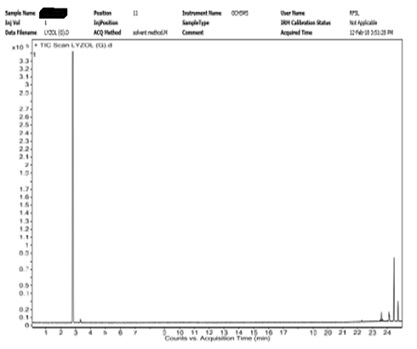 Figure 1: TIC of A
Figure 1: TIC of A 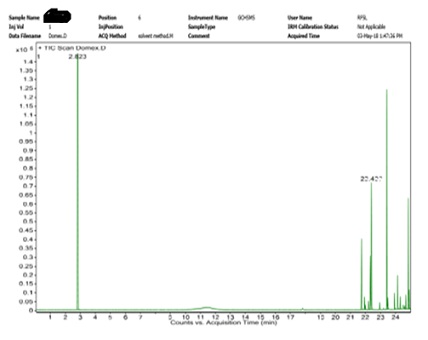
Figure 2: TIC of B
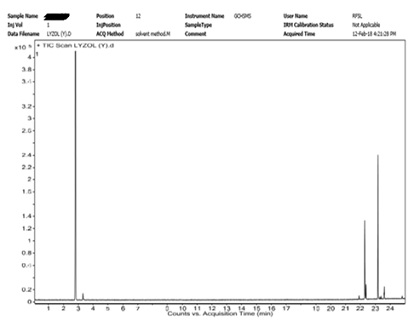 Figure 3: TIC of C
Figure 3: TIC of C
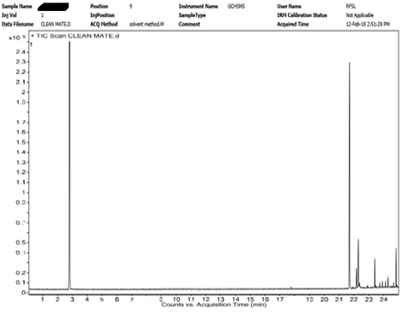 Figure 4: TIC of D
Figure 4: TIC of D
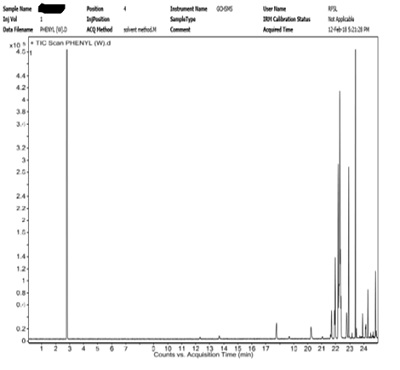 Figure 5: TIC of E
Figure 5: TIC of E
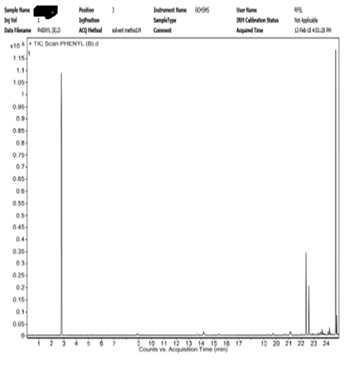 Figure 6: TIC of F
Figure 6: TIC of F
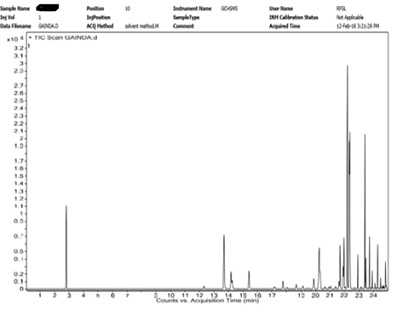 Figure 7: TIC of G
Figure 7: TIC of G
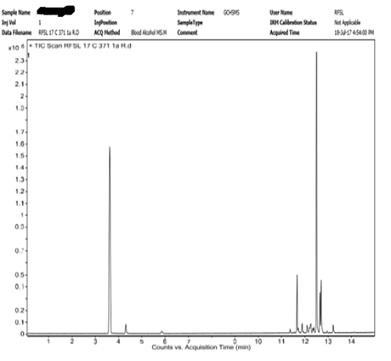 Figure 8: TIC of forensic Sample 1
Figure 8: TIC of forensic Sample 1
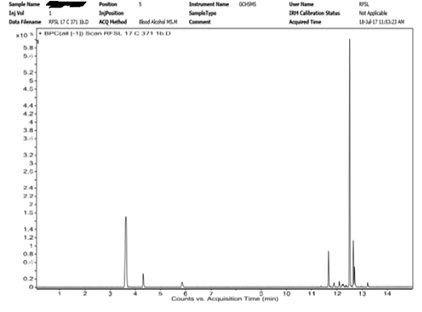 Figure 9: TIC of forensic Sample 2
Figure 9: TIC of forensic Sample 2
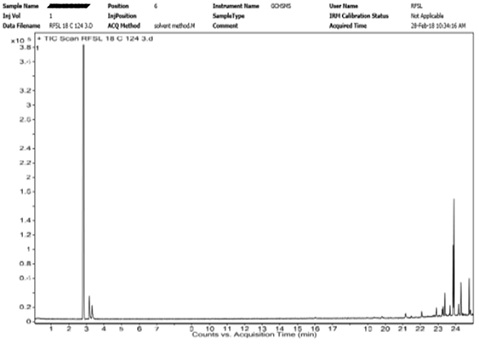 Figure 10: TIC of forensic Sample 3
Figure 10: TIC of forensic Sample 3
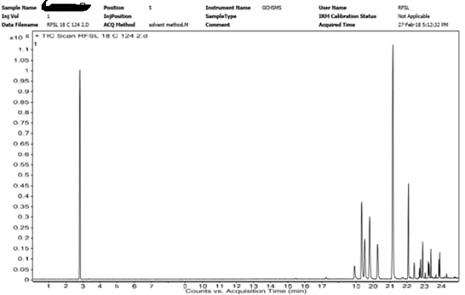 Figure11: TIC of forensic Sample 4
Figure11: TIC of forensic Sample 4
|
Name of Compound |
m/z |
Market Products |
Case Exhibits |
|||||||||
|
A |
B |
C |
D |
E |
F |
G |
8 |
9 |
10 |
11 |
||
|
Bicyclo hepta-2,6-diene |
91,92,39 |
|
+ |
|
|
|
|
|
+ |
+ |
+ |
+ |
|
Bicyclo hex-2-ene, 2 methyl 5 -(1- methyl ethyl) |
93,91,77 |
+ |
|
+ |
|
+ |
|
+ |
|
|
|
|
|
Cyclo Hexane |
56,84,41 |
+ |
|
|
+ |
+ |
|
+ |
|
|
|
|
|
O-Xylene |
91,106, 105 |
|
|
|
+ |
|
|
|
|
|
|
|
|
Iso Borneol |
95,41,93 |
+ |
|
+ |
+ |
|
|
+ |
+ |
+ |
|
|
|
Camphene |
93,121,79 |
|
|
|
+ |
|
|
+ |
+ |
+ |
|
|
|
Camphor |
95,41,81 |
|
|
|
|
|
|
+ |
|
|
|
|
|
Mesitylene |
105, 120, 119 |
|
+ |
|
|
|
|
|
|
|
|
+ |
|
Naphthalene |
128, 129, 127 |
|
+ |
|
|
|
+ |
|
|
|
+ |
+ |
|
Naphthalene 2 methyl |
155, 184, 156 |
|
|
+ |
|
|
+ |
|
|
|
+ |
+ |
|
Benzene 1,3-dimethyl |
91,106,105 |
|
+ |
|
+ |
|
|
|
+ |
+ |
+ |
+ |
|
Benzene 1-ethyl 2,4 dimethyl |
119,134, 91 |
|
+ |
|
+ |
|
|
|
+ |
+ |
+ |
+ |
|
Benzene 1-methyl 3 (1-methyl ethyl) |
133,105,148
|
+ |
|
+ |
|
|
|
|
+ |
+ |
+ |
+ |
|
Benzene 1-isocyano 3- methyl |
133,104, 132 |
|
+ |
|
|
|
|
|
+ |
+ |
+ |
+ |
|
Benzofuran, 2- methyl |
131,132 103 |
|
+ |
|
|
|
|
|
+ |
+ |
+ |
+ |
|
Indane |
117, 118, 115 |
|
+ |
|
|
|
|
|
|
|
|
+ |
|
Indane 1-methyl |
117,132, 115 |
|
+ |
+ |
|
|
|
|
|
|
|
|
|
Isopropyl- 2- methyl cycle hexane -2 |
57, 43, 71 |
|
|
|
+ |
|
|
|
|
|
+
|
|
|
Formamide |
45, 29, 17 |
|
|
|
|
+ |
+ |
|
|
|
|
|
|
Acetaldehyde |
29,44,43 |
|
|
|
+ |
|
|
|
|
|
|
|
|
Ethanol |
31, 45, 29 |
|
|
|
|
|
|
|
|
|
+ |
|
|
Fenchol |
81,80,43 |
|
|
+ |
|
|
|
+ |
|
|
|
|
Table 1: List of chemical constituents’ detected and comparative compilation with Forensic samples.
Discussion
In the recent years, HS-GC-MS is readily used for the efficient separation and identification of even trace amounts of volatile organic compounds with high reproducibility in various matrices. The purpose to select HS-GC-MS instrument for analysis is that it significantly reduces sample preparation time, ensures contamination less analysis, rapid results and is extremely useful in the examination of volatile components in forensic samples which generally have a very wide spectrum of matrices.
HS-GC-MS examination of commercial cleaning products (Table 1 and Figures 1-7) contained a wide variety chemicals including derivatives of naphthalene and benzene along with oils, terpenes, camphor, cyclohexane compounds, acetaldehyde and formamide. The range of oils and terpenes detected in commercial products indicate the existence of fragrance in these cleaning products. Studies indicate that oils are used in many cleaning products because of their mild disinfectant properties [19]. The results showed cleaning products were in consistent with the chemical substances found in biological samples which goes well with famous Locard’s principle [20, 21] for analysis extensively used in forensic examination.
In Case I, both Gastric Lavage samples marked as No 8 and 9 in Table 1 show similarity in composition of chemical constituents detected. Such similarity with market products form a strong base for conclusive interpretation in forensic exhibits, considering locard’s principle. The chemical composition of gastric lavage I and II confirmed the presence of various derivatives of cyclohexane and naphthalene along with natural oils and flavoring products like - D- limonene, Eucalyptol, Carene and menthane used for fragrance in cleaning products [22, 23]. Mesitylene was not detected in gastric lavage sample in Case II but was detected in suspected liquid. Other benzene derivatives were successfully detected and tallied.
In toxicological examination of poisoning cases, the effect of poisoning is undoubtedly quantity and concentration dependent. In Case I, the quantity and concentration could have been low as observed in medico legal examination. Therefore, documentation and observation by medical expert play an equally important role. Also, timely medical help could have decreased the toxic effect of poison. The cause of death in Case II may not only be exclusively due to excessive quantity and concentrated, but also due to the cumulative effect of ethyl alcohol as the gastric lavage sample showed presence of alcohol. So, under the influence of alcohol an excessive quantity of poison could have been consumed. Another foremost reason, for case samples to slightly deviate from market products is due to unknown composition of stomach contents and duration of medical treatment. In either condition, a clear similarity among chemical constituents can be observed to interpret the case samples, congruence with locard’s principle (Figures 8-11). The chemical characterization and comparison with forensic samples also indicated that these major volatile compounds found, are not produced by normal healthy human body in any condition.
The cleaning agent additives usually have low toxicity but can cause acute respiratory irritation and CNS depression16. Systemic toxicity occurs due to wide range of composition of terpenes. Aromatics compounds lead to mild CNS depression, nausea, vomiting diarrhea, headache restlessness etc. and hence, it is understandable that the victims were presented for MLC with parallel symptoms. Therefore, taking the above into consideration, conclusion was reached in both the cases that the chemicals detected in biological samples were due to poisoning from household cleaner ingestion.
This study also aims to provide forensic evaluation of cases under consideration. The age of the victim, time duration of incidence, time elapsed between occurrence of incidence and medical assistance, dose of poison, health of victim all determine the quality and quantity of samples sent for forensic analysis. Further, the samples sent to forensic laboratories should also be in sealed condition to avoid loss of volatile compounds besides careful collection of samples during scene of crime examination unfolds significance of circumstantial evidences during the crime investigation. A detailed assessment of various parameters in case II was decisive for forensic reporting due to presence of suspected liquid in case samples, which was absent in case I. Although most of these cases are suicidal in nature, owing to which the victim more than often provides an ambiguous history of events which the investigating agencies must look at. But, accidental poisoning due to house hold cleaning agents could not be ruled out in our case study. Also, considering the low conviction rate in India as compared to other developed nations, findings suggest the importance of appropriate assessment of chemical examination, proper documentation, a scientific approach for evidence collection to yield conclusive results in an organized time frame in order to support investigating agencies is the need of the hour.
Conclusion
The presence of variety of chemicals having anti-microbial properties, various solvents, oils and other miscellaneous volatile chemicals with the help of instrument HS-GC-MS in biological fluids clearly indicates a case of household cleaner poisoning. HS-GC-MS instrument was found suitable, due to rapid and distinct identification of organic volatile chemicals which are thermally sensitive. Even small amount of case samples can be successfully identified which is an essential prerequisite in forensic arena. The presence of similar compounds in household cleaning product and biological fluids is an indication for cleaning product poisoning. The products were detected even when the victim has undergone medical treatment. The challenges faced by forensic scientist while interpreting results obtained in cases pertaining to ingestion of suspected household cleaning product as poison has been clearly elucidated along with few significant conditions indispensable to maximize positive reporting. This study can resolve analogous cases conclusively by forensic toxicologist to enhance jurisprudence. However, it must be noted that this study is merely a pilot study for detection of components in cleaners and further reserves to carry out detailed study in India.
Declarations
Ethical approval and consent to participate – Not applicable
Adherence to National and International Regulations –– Not applicable
Consent for publication- – Not applicable
Availability of data and material – Forensic Science Laboratory, Delhi, India
Competing Interests- The authors declare that they have No Competing Interests
Funding – None received
Author's Contribution
- Dr. Sweta Sinha - Study conception and design, Acquisition, Analysis & Interpretation of Data, original draft and editing.
- Dr. Adesh kumar – Study conception, Interpretation of Data & editing draft.
- Dr. Kavita Goyal – Interpretation of Data & Review of draft.
Acknowledgement
The authors gratefully acknowledge perpetual support and motivation of Ms Deepa Verma, Director, Forensic Science Laboratory, Delhi and Shri Srinarain, Head of Office/Assistant Director, Forensic Science Laboratory, Delhi in pursuing research activities.
References
- Mohd AH, Adnan L, Kamaldin J, Mohamad N, Shariff M, et al. (2013) The Risk of Accidental Chemical Poisoning Cases among Children (≤12 Years Old) Admitted to Hospital University Sains Malaysia: 5 Years Review. J Clinic Toxicol.
- Patra AP, Shaha KK (2017) Household Chemicals and Pharmaceuticals - A Lurking Danger in Home. Forensic Res Criminol Int J, 5: 302-304.
- Fung HT, Lam KK, Wong OF, Lai CH, Kam CW (2007) Metabolic acidosis complicating ingestion of disinfectant Household cleaner containing butoxyethanol. Hong Kong J E merg Med, 14: 99-102.
- Chan TYK (1995) Poisoning due to common house hold product. Singapore Med J, 36: 285-287.
- Manjhi SN, Buktar SB, Mukherjee BB, Farooqui JM (2015) Suicidal Death Due to Floor Cleaning Material: A Case Report. Pravara Med Rev, 7: 25-28.
- National Crime Records Bureau (2015) Crime in India 2015 statistics, India.
- Amit P, Rahul P, Vikas C, Sahay V, Hemangi G (2014) Profile of Acute Poisoning Cases Treated in a Tertiary Care Hospital: a Study in Navi Mumbai. Asia Pacific Journal of Medical Toxicology (APJMT), 3: 36-40.
- Pillay VV (2017) Textbook of Forensic medicine Pillay VV. Organic Acids. Modern Medical Toxicology.4th Ed. New Delhi: JAYPEE brother’s medical publishers (P) Ltd, 1-627.
- Parikh C K (2012) Parikh’s Textbook of Medical Jurisprudence Forensic Medicine and Toxicology,6th Edition, CBS Publishers, New Delhi.
- Swain R, Behera C, Gupta SK (2016) Fatal corrosive ingestion: A study from South and South-East Delhi, India (2005-2014). Med Sci Law, 56: 252-257.
- Shan L, Leong AYK, Man DCK, Keung CC (2019) Factors that affect mortality in local patients who ingested common household cleansing products and required intubation. Hong Kong Journal of Emergency Medicine, 27: 334-343.
- Kumar A, Siddams H (2019) Poisoning Death trends in North East Delhi – A Retrospective Study. Journal of Indian Academy of Forensic Medicine, 38: 213-216.
- Shah PS, Gupta YK (2018) Poisoning due to household products: A ten years retrospective analysis of telephone calls to the National Poisons Information Centre, All India Institute of Medical Sciences, New Delhi, India.
- Gerster FM, David V, Wild PP, Hopf NB (2014) Hazardous substances in frequently used professional cleaning products. International Journal of Occupational and Environmental Health, 20: 46-60.
- Anila B, Margaret MQ , Melissa JP, Donald K M (2009) Characterization of occupational exposures to cleaning products used for common cleaning tasks-a pilot study of hospital cleaners , Environmental Health.
- Thomas MS, David HS, Hammerstrom K, Remmers J (1992) A Survey of Household Products for Volatile Organic Compounds. Atmospheric Environment, 26: 1063-1070.
- Yadav P, Singh R (2015) Thin Layer Chromatographic Analysis of some Disinfectant Household Cleaner: A First Report. Austin J Forensic Sci Criminol, 2: 1035.
- Julie CSL, Jutkowitz A (2009) Chapter 77 - Approach to Poisoning and Drug Overdose. Editor(s): Deborah C. Silverstein, Kate Hopper, Small Animal Critical Care Medicine, W.B. Saunders, Pages 326-329.
- Martz W (2010) A Lethal Ingestion of a Household Cleaner Containing Pine Oil and Isopropanol, Journal of Analytical Toxicology, 34: 49-52.
- Forensic Science (2022) Encyclopedias-almanacs-transcripts-and-maps locards-exchange-principle.
- Roncacè S, Nicosia U (2016) "...Every contact leaves a trace...” Locard 1920.
- Rastogi SC, Heydorn S, Johansen JD, Basketter DA (2001) Fragrance chemicals in domestic and occupational products, Contact Dermatitis - Wiley Online Library, 45: 221-225.
- Huang Y, Ho SSH, Ho KF, Lee SC, Gao Y, et al. (2011) Characterization of Biogenic Volatile Organic Compounds (BVOCs) in Cleaning products and Air Fresheners in Hong Kong. Atmospheric Environment.45: 6191-6196.
Citation: Sinha S, Kumar A, Goyal K (2022) Chemical Signature of Household Cleaning Products to Unveil Crime – Forensic Evaluation of Case Study. Forensic Leg Investig Sci 8: 062.
Copyright: © 2022 Sweta Sinha, et al. This is an open-access article distributed under the terms of the Creative Commons Attribution License, which permits unrestricted use, distribution, and reproduction in any medium, provided the original author and source are credited.

